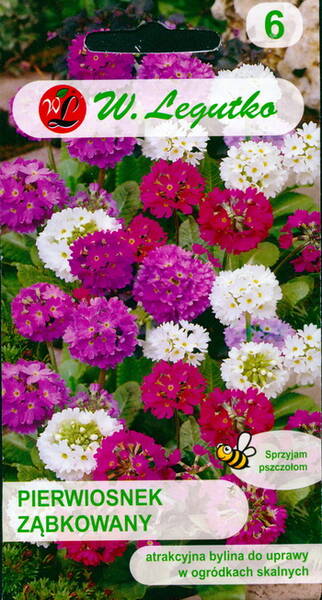Your shopping cart is empty!
Drumstick primrose (mix)
Drumstick primrose (mix) - Primula denticulata.
This plant will give you a unique feeling of delight when, among the awakening, almost devoid of colours garden, wonderful bright flowers and fresh green leaves suddenly appear!
Homeland: Himalayas, Western China.
A plant with large, oblong-oval, finely toothed, very wrinkled leaves, mealy on the underside. The arrow at the beginning of flowering is 10-15 cm, by the period of fruiting it stretches to 60-70 cm in height. The flowers are pale pink with a yellow throat, small, up to 1.5 cm in diameter, collected in a dense capitate inflorescence up to 10 cm in diameter. It blooms from April for 30-40 days and has excellent winter hardiness. There are up to 18,000 seeds in 1 g. In culture since the 19th century.
Location: prefers semi-shaded places.
Soil: sufficiently moist soil with the addition of turf soil and organic fertilizers in the form of compost, leaf soil and well-decomposed humus. In light sandy soils, 10 kg of compost soil, 5 kg of humus and 5 kg of peat are added per 1 m2 for digging. On heavy clay soils, in addition to the specified organic fertilizers, add 1-2 buckets of sand per 1 m2. The soil should be cultivated to a depth of 20 cm and well-raked.
Care: does not require much care. The soil should always be moist, loose and free of weeds. In spring, primroses are very demanding of moisture, but cannot tolerate stagnant water. After flowering, if possible, you should water them well with highly diluted slurry or feed them with a small dose of complete mineral fertilizer at the rate of 20-30 g/m2. If you do not divide primroses for a long time, they can freeze out, since the rhizome with the bulk of the roots is located close to the soil surface.
A year or two after planting, you can add nutritious soil to the roots in the fall so that the growing rhizomes do not freeze. For a good overwintering of plants, it is important to preserve the rosette of leaves until late autumn, as it serves as a natural shelter. Species such as fine-toothed primrose, common primrose and Japanese primrose are recommended to be covered with a 10 cm layer of dry tree leaves for the winter.
Use: unpretentiousness when growing, cold resistance, early and very long flowering have made primrose indispensable in places with a cool and humid climate.
In any garden there are always more or less inconvenient places where, it seems, nothing good will grow. In this case, primroses will help out. Among them, you can choose a group of the most unpretentious species, which, although they do not shine with special brightness and beauty, will still delight you with their freshness. These species include Primula veris, Primula vulgaris, Primula macrocalyx.
This plant will give you a unique feeling of delight when, among the awakening, almost devoid of colours garden, wonderful bright flowers and fresh green leaves suddenly appear!
Homeland: Himalayas, Western China.
A plant with large, oblong-oval, finely toothed, very wrinkled leaves, mealy on the underside. The arrow at the beginning of flowering is 10-15 cm, by the period of fruiting it stretches to 60-70 cm in height. The flowers are pale pink with a yellow throat, small, up to 1.5 cm in diameter, collected in a dense capitate inflorescence up to 10 cm in diameter. It blooms from April for 30-40 days and has excellent winter hardiness. There are up to 18,000 seeds in 1 g. In culture since the 19th century.
Location: prefers semi-shaded places.
Soil: sufficiently moist soil with the addition of turf soil and organic fertilizers in the form of compost, leaf soil and well-decomposed humus. In light sandy soils, 10 kg of compost soil, 5 kg of humus and 5 kg of peat are added per 1 m2 for digging. On heavy clay soils, in addition to the specified organic fertilizers, add 1-2 buckets of sand per 1 m2. The soil should be cultivated to a depth of 20 cm and well-raked.
Care: does not require much care. The soil should always be moist, loose and free of weeds. In spring, primroses are very demanding of moisture, but cannot tolerate stagnant water. After flowering, if possible, you should water them well with highly diluted slurry or feed them with a small dose of complete mineral fertilizer at the rate of 20-30 g/m2. If you do not divide primroses for a long time, they can freeze out, since the rhizome with the bulk of the roots is located close to the soil surface.
A year or two after planting, you can add nutritious soil to the roots in the fall so that the growing rhizomes do not freeze. For a good overwintering of plants, it is important to preserve the rosette of leaves until late autumn, as it serves as a natural shelter. Species such as fine-toothed primrose, common primrose and Japanese primrose are recommended to be covered with a 10 cm layer of dry tree leaves for the winter.
Use: unpretentiousness when growing, cold resistance, early and very long flowering have made primrose indispensable in places with a cool and humid climate.
In any garden there are always more or less inconvenient places where, it seems, nothing good will grow. In this case, primroses will help out. Among them, you can choose a group of the most unpretentious species, which, although they do not shine with special brightness and beauty, will still delight you with their freshness. These species include Primula veris, Primula vulgaris, Primula macrocalyx.











